In a nutshell, nitrous purge (commonly called NOS) is a system that clears nitrous oxide from the feed lines to ensure optimal performance when using nitrous oxide injection. Now, let’s explore the fascinating world of nitrous purge and find out how it can enhance your driving experience.
Understanding Nitrous Oxide Injection
The Basics of Nitrous Oxide
Before we delve into nitrous purge, let’s first understand the concept of nitrous oxide injection. Nitrous oxide, also known as N2O or simply “nitrous,” is a colorless, non-flammable gas that is commonly used as a performance enhancer for internal combustion engines.
When introduced to an engine, it provides a temporary increase in horsepower and torque, giving your vehicle a significant performance boost.
How Nitrous Oxide Injection Works
Nitrous oxide injection works by introducing the gas into the engine’s intake manifold, where it mixes with the air/fuel mixture. When this mixture is ignited in the combustion chamber, the nitrous oxide breaks down, releasing oxygen and nitrogen.
The additional oxygen allows for more fuel to be burned, resulting in a more powerful combustion process and increased engine output.
The Purpose and Function of Nitrous Purge
Clearing the Lines
The primary purpose of a nitrous purge system is to clear any gaseous nitrous oxide from the feed lines before it is injected into the engine. This ensures that the nitrous oxide is in its liquid state when it reaches the engine, providing a more consistent and effective performance boost.
By purging the lines, you can avoid inconsistent nitrous delivery, which can lead to engine damage or reduced performance.
A Visual Display of Power
Another reason car enthusiasts love nitrous purge is the visual effect it creates. When the purge valve is activated, it releases a plume of nitrous oxide vapor, creating a dramatic white cloud that is often accompanied by a hissing sound.
This eye-catching display is not only impressive to onlookers but also serves as a warning to competitors that your vehicle is packing some serious power.
Installing and Using a Nitrous Purge System
Components of a Purge System
A typical nitrous purge system consists of several components, including a purge solenoid, a purge nozzle, wiring, and a switch to activate the purge. The solenoid is connected to the main nitrous supply line and the purge nozzle, which is usually mounted in a visible location, such as near the hood or front bumper.
Operating the Purge System
To operate the nitrous purge system, simply press the purge button or flip the switch. This activates the purge solenoid, which allows nitrous oxide to flow from the supply line, through the nozzle, and out into the atmosphere.
The purge process should be performed before using nitrous oxide injection to ensure optimal performance.
The Benefits of Nitrous Purge
Improved Performance Consistency
By purging the nitrous lines before use, you ensure that the nitrous oxide is in its liquid state when it reaches the engine. This provides more consistent and effective performance gains, reducing the risk of engine damage due to inconsistent nitrous delivery.
Enhanced Visual Appeal
As mentioned earlier, the nitrous purge system creates a dramatic visual display that is sure to turn heads and impress onlookers. This eye-catching effect adds an extra layer of excitement and appeal to your vehicle, making it stand out from the crowd.
Cooling Effect on Intake Air
Another benefit of the nitrous purge system is the cooling effect it has on the intake air. As the nitrous oxide vaporizes during the purge process, it absorbs heat from the surrounding air. This results in a cooler air charge entering the engine, which can lead to increased power output and improved efficiency.
Safety Considerations and Precautions
Proper Installation
To ensure the safe and effective operation of your nitrous purge system, it is crucial to follow the manufacturer’s guidelines for installation. This includes using the correct components, securing all connections, and mounting the purge nozzle in a suitable location.
Regular Maintenance
Like any other performance modification, a nitrous purge system requires regular maintenance to ensure it continues to function optimally. This includes checking for leaks, ensuring the solenoid is functioning correctly, and periodically replacing any worn or damaged components.
Responsible Use
It is essential to use your nitrous purge system responsibly and in accordance with local laws and regulations. Purging nitrous oxide in enclosed spaces or near ignition sources can be dangerous and should be avoided.
FAQs
- Can a nitrous purge system damage my engine? A properly installed and maintained nitrous purge system should not damage your engine. In fact, by ensuring consistent nitrous delivery, it can help protect your engine from damage caused by inconsistent nitrous injection.
- How often should I purge my nitrous system? It is generally recommended to purge your nitrous system before each use of the nitrous oxide injection. This ensures that the nitrous oxide is in its liquid state when it reaches the engine, providing consistent and effective performance gains.
- Can I install a nitrous purge system on any vehicle? While a nitrous purge system can be installed on most vehicles equipped with a nitrous oxide injection system, it is essential to consult your vehicle’s manufacturer and the nitrous system supplier to ensure compatibility and proper installation.
- Is it legal to use a nitrous purge system on public roads? Laws regarding the use of nitrous purge systems on public roads vary by jurisdiction. It is essential to familiarize yourself with local regulations and use your nitrous purge system responsibly and in accordance with the law.
- How much does a nitrous purge system cost? The cost of a nitrous purge system can vary depending on the specific components and features you choose. On average, expect to pay between $100 and $300 for a complete purge system, not including installation.


